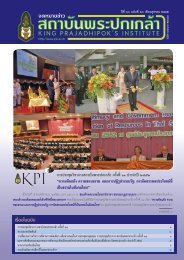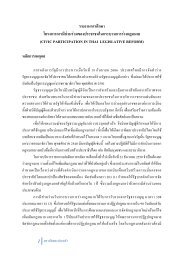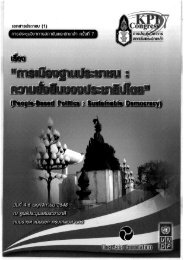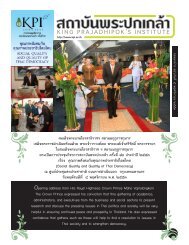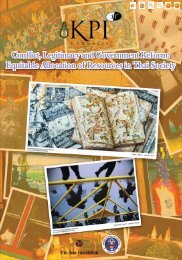SUFFiciENcy EcONOMy ANd GRASSROOtS DEvElOPMENt
SUFFiciENcy EcONOMy ANd GRASSROOtS DEvElOPMENt
SUFFiciENcy EcONOMy ANd GRASSROOtS DEvElOPMENt
You also want an ePaper? Increase the reach of your titles
YUMPU automatically turns print PDFs into web optimized ePapers that Google loves.
306<br />
The Meaning of Sufficiency Economy <br />
International Conference<br />
1. Definition of Social Capital<br />
Pierre Bourdieu (1985 cited from Portes A. 1998: 1-24) was the first person to<br />
have systematically analyzed the concept of social capital. Bourdieu has developed<br />
the concept of social capital and cultural capital in the period between 1970 and<br />
1980. He distinguished these forms of capital from economic capital (money,<br />
property, and what Marx termed “productive capital”). Cultural capital encompasses<br />
the commodities of culture including arts, knowledge and educational qualifications.<br />
Bourdieu defines social capital as having the following contents:<br />
(1) Social Capital is a source that defines the relationship between group<br />
members and social networks.<br />
(2) Social capital has the characteristics of symbolic capital.<br />
(3) Social capital can be transformed into economic capital.<br />
Coleman (1988: 95-120) has explained social capital as being a function of<br />
relations among humans geared to certain expectations based on trust. Social capital<br />
based on trustful relationships can lead to higher individual benefits than in relations<br />
that do not involve trust. Social capital is facilitated in cultures with shared values<br />
among members. Coleman specifies social capital further as follows: <br />
(1) Embedded relationship enhanced with commitment and anticipation of the<br />
actions of others; trust and confidence in each other; mutual access to<br />
information channels; upholding social norms and (tacitly) agreed upon<br />
concrete punishment measures.<br />
(2) Social structures define relationships facilitating networking and a suitable<br />
organizational culture.<br />
2. Elements of Social Capital according to NESDB<br />
The Advisory Council of the National Economic & Social Development Board<br />
(B.E.2548: pp.12-15) has recommended the classification of social capital into <br />
4 dimensions as follows:<br />
(1) Human capital, which generally means people, including social leaders,<br />
village scholars, and volunteers, who can be characterized by the will to<br />
volunteer, can be trusted, are generous, recognize the interconnectedness<br />
among all people, have a generous spirit and adhere to ethical values.<br />
Ethics includes discipline, integrity and social awareness; moreover people<br />
understand the general interest of society as a whole, including patriotism.<br />
People should be of good health and know how to protect themselves. TAO<br />
Tha Kham focused on the development of human capital, emphasizing<br />
quality of life in the development of the community economy; the<br />
empowerment of the community thus went hand in hand with the<br />
strengthening of social capital through the establishment of village saving



